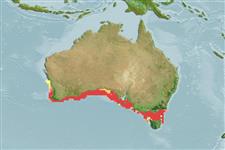Ikan bertulang rawan (sharks and rays) >
Orectolobiformes (Carpet sharks) >
Parascylliidae (Collared carpet sharks)
Etymology: Parascyllium: para (Gr.), near, i.e., presumed to be related to Scyliorhinus (now in Scyliorhinidae): skylion, Greek for dogfish or small shark (See ETYFish); variolatum: Latin for spotted, referring to white spots that sprinkle body (See ETYFish).
More on author: Duméril.
Environment: milieu / climate zone / depth range / distribution range
Ekologi
laut dasar (demersal); kisaran kedalaman ? - 180 m (Ref. 6871). Temperate; 37°S - 42°S, 113°E - 150°E (Ref. 54701)
Eastern Indian Ocean: endemic to Australia.
Size / Weight / umur
Maturity: Lm ? range ? - ? cm
Max length : 91.0 cm TL jantan/; (Ref. 247)
Found on the continental shelf at depths of inshore down to about 180 meters. Apparently occurs in a variety of habitats, including sandy bottom, on rocky reefs, in beds of kelp, and in seagrass beds, details of it ecology is, however, virtually unknown (Ref. 43278). Oviparous (Ref. 6871).
Life cycle and mating behavior
Kematangan | Reproduksi, perkembang biakan | Pemijahan | telur-telur | Fecundity | Larva
Oviparous, paired eggs are laid. Embryos feed solely on yolk (Ref. 50449).
Compagno, L.J.V., 1984. FAO Species Catalogue. Vol. 4. Sharks of the world. An annotated and illustrated catalogue of shark species known to date. Part 1 - Hexanchiformes to Lamniformes. FAO Fish. Synop. 125(4/1):1-249. Rome, FAO. (Ref. 247)
Status IUCN Red List (Ref. 130435: Version 2024-1)
ancaman kepada manusia
Harmless
penggunaan manusia
Perikanan: tidak ada kepentingan
Alat, peralatan
laporan khas
muat turun XML
Sumber internet
Estimates based on models
Preferred temperature (Ref.
123201): 14.6 - 18.3, mean 16.8 °C (based on 174 cells).
Phylogenetic diversity index (Ref.
82804): PD
50 = 0.5352 [Uniqueness, from 0.5 = low to 2.0 = high].
Bayesian length-weight: a=0.00389 (0.00180 - 0.00842), b=3.12 (2.94 - 3.30), in cm total length, based on all LWR estimates for this body shape (Ref.
93245).
Trophic level (Ref.
69278): 3.8 ±0.6 se; based on size and trophs of closest relatives
Daya lenting (Ref.
120179): Rendah, Waktu penggandaan populasi minimum 4.5 - 14 tahun (Fec assumed to be <100).
Fishing Vulnerability (Ref.
59153): High vulnerability (56 of 100).
Nutrients (Ref.
124155): Calcium = 12.1 [2.4, 53.3] mg/100g; Iron = 0.254 [0.069, 0.719] mg/100g; Protein = 18.9 [16.8, 20.8] %; Omega3 = 0.41 [0.18, 0.89] g/100g; Selenium = 12.8 [3.9, 33.7] μg/100g; VitaminA = 9.56 [2.96, 29.00] μg/100g; Zinc = 0.422 [0.206, 0.758] mg/100g (wet weight);
